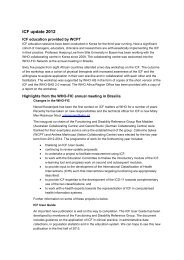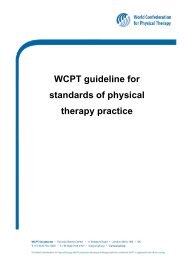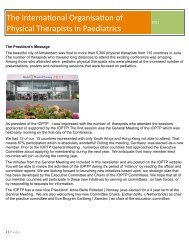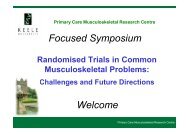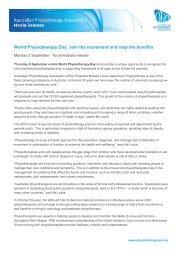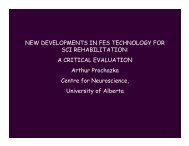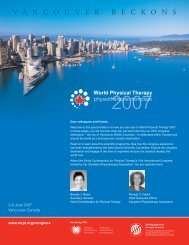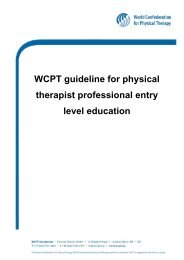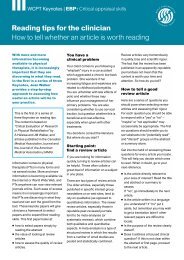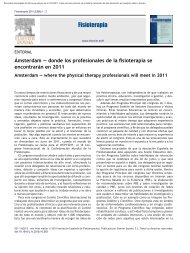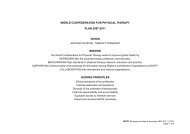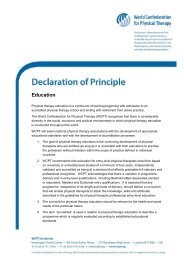wcpt congress: event of a lifetime - World Confederation for Physical ...
wcpt congress: event of a lifetime - World Confederation for Physical ...
wcpt congress: event of a lifetime - World Confederation for Physical ...
Create successful ePaper yourself
Turn your PDF publications into a flip-book with our unique Google optimized e-Paper software.
PROFESSIONAL ISSUES<br />
ARTHRITIS: THE PHYSIOTHERAPISTS<br />
WHO TREAT IT<br />
Fun with fitness<br />
For fourteen years she’s been taking<br />
an exercise class aimed at people<br />
with arthritis – and many <strong>of</strong> the same<br />
people are still coming! It’s a class <strong>of</strong><br />
36, with usually about 20 at any one<br />
time, and includes a lot <strong>of</strong> husband<br />
and wife teams but no single men.<br />
The youngest participant is 50.<br />
“My goal is to keep them fit, not make<br />
money, says Sandy Juergens “– but I’m<br />
also getting my exercise.”<br />
All types <strong>of</strong> arthritis are represented:<br />
“Joint replacements, general OA,<br />
specific joints – a conglomeration. And<br />
it’s not limited to arthritis; a few others<br />
come along.”<br />
Twice a week Sandy runs this one-hour<br />
class in the Gospel Hall in Rangiora,<br />
charging $3 per class or $5 <strong>for</strong> two<br />
classes in the week.<br />
• 20 minutes: warm-up with stretches<br />
– more than <strong>for</strong> a regular class, more<br />
range <strong>of</strong> motion<br />
• 20 minutes: toning exercises – more<br />
balance and core exercises than in<br />
most exercise classes – many do<br />
them on the floor, some standing,<br />
some do the entire class sitting. “It<br />
doesn’t matter what stage they are<br />
at, they can benefit from the class.”<br />
• 20 minutes: cardio workout – low impact<br />
aerobic dancing, ending with a<br />
minute <strong>of</strong> posture exercises (low back<br />
extensions, backward shoulder rolls,<br />
chin tucks). As a <strong>for</strong>mer dancer, Sandy<br />
choreographs all the dances herself.<br />
• Sandy allows a few moments <strong>for</strong><br />
instructions and questions, or stays<br />
on a little longer.<br />
Anyone joining the class completes<br />
a medical in<strong>for</strong>mation <strong>for</strong>m, and is<br />
given a handout. Sandy ensures that<br />
each participant takes their pulse twice<br />
during every class.<br />
The number one rule <strong>of</strong> the class is to have fun, Sandy tells her group. “That’s why<br />
they keep coming back. If it’s just hard work, people probably won’t keep it up.”<br />
Physiotherapy <strong>for</strong> haemophilia<br />
Physiotherapy management <strong>of</strong><br />
haemophilia has changed considerably<br />
in recent times. A more proactive<br />
focus on this group <strong>of</strong> patients with a<br />
high-cost, chronic condition has been<br />
successful in the Auckland region.<br />
Once haemophilia’s vicious<br />
cycle <strong>of</strong> bleeding and adaptive<br />
musculoskeletal changes starts,<br />
it can be difficult to stop the<br />
accelerated arthritis which<br />
characterises this condition<br />
A Changing Population<br />
Young men growing up today are<br />
<strong>for</strong>tunate to have far less chronic<br />
joint damage than their older peers.<br />
Older men with haemophilia who<br />
did not have access to factor concentrates<br />
or prompt physiotherapy rehabilitation<br />
as children are characterised<br />
by severe, multiple-joint arthropathy<br />
and significant disability.<br />
A vicious cycle: historical<br />
management<br />
Once haemophilia’s vicious cycle <strong>of</strong><br />
bleeding and adaptive musculoskeletal<br />
changes starts, it can be difficult to<br />
stop the accelerated arthritis which<br />
characterises this condition, explains<br />
Ian d’Young, who is employed by<br />
Auckland DHB as Haemophilia Physiotherapy<br />
Practitioner.<br />
Historically, once blood entered the<br />
joint cavity, a patient was sent to bed<br />
<strong>for</strong> a few weeks to rest and recover.<br />
Un<strong>for</strong>tunately this meant that muscle<br />
proteins were metabolised, flexion<br />
contractures would develop, and<br />
coordination and aerobic capacity<br />
would deteriorate. A vicious cycle <strong>of</strong><br />
repeated bleeding, muscle shortening,<br />
weakness, proprioceptive and<br />
biomechanical changes then occurred<br />
while the patient was immobile and<br />
awaited physiotherapy management.<br />
Most young men with haemophilia<br />
had there<strong>for</strong>e developed severe joint<br />
damage by their early teens, resulting<br />
in life-long disability.<br />
New model <strong>of</strong> care<br />
The weaker, stiffer, less co-ordinated a<br />
patient, the higher the risk <strong>of</strong> bleeding.<br />
We know that while joint damage is<br />
proportional to the number <strong>of</strong> bleeds<br />
that have occurred, it is also proportional<br />
to the speed <strong>of</strong> rehabilitation.<br />
08 | PHYSIO MATTERS AUGUST 2011



